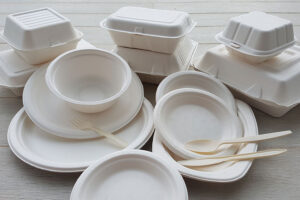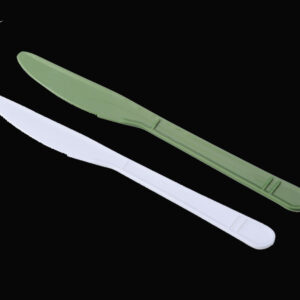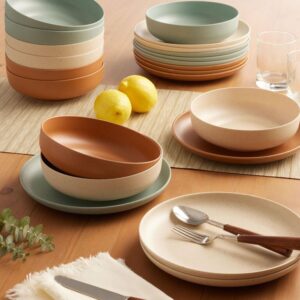
1. What are the raw materials used in the disposable biodegradable tableware and their respective ratios?
Conventional lunch boxes generally follow the ratio of 70%-90% sugarcane fiber + 10%-30% bamboo pulp fiber. Different tableware will also adjust different fiber ratios according to the product shape, angle, hardness, and stiffness. Of course, plant fibers such as wheat straw, wheat straw, and the reed will also be added as needed. It is all made of plant fiber, no chemical materials such as PP and PET are added.
2. How to achieve the waterproof and oil-proof effect of the disposable pulp lunch box?
Certain food-grade additives are added to the pulp molded lunch box, general water-repellent agent: 1.0%-2.5%, oil-repellent agent: 0.5%-0.8%, to achieve the effect of waterproof and oil-proof. The test is generally 100°C water, 120°C oil, and the test time is 30 minutes; special requirements can be done to extend the oil temperature and test time.
3. Does the degradable disposable tableware products contain fluorine?
At present, most of the oil repellents in plant fiber tableware on the market are fluorine-containing, and water- and oil-proof tableware is fluorine-free.
If the biodegradable tableware is required to be fluorine-free and water- and oil-proof, the current better alternative is film coating. PBAT is a wider application range and more composite materials used in the current pulp-molded environmentally-friendly tableware.
The coated product can better maintain heat preservation, reduce the heat dissipation through the pores of the molded product, and reduce the stickiness of food such as rice and dumplings, which can greatly reduce the use of water-repellent and oil-repellent agents.
4. How long can the environmentally friendly pulp tableware be completely degraded?
Without any industrial decomposer, it takes about 45-90 days for the pulp molded environmentally friendly tableware to completely decompose in the natural state of the landfill. No harmful ingredients are produced, and it will not cause harm to terrestrial organisms, marine corals, or marine organisms.
After degradation, 82% of the ingredients are organic matter, which can be used as fertilizer for land use, using natural materials, and returning to nature
5. Can disposable paper pulp tableware be heated in the microwave and refrigerated in the refrigerator? How much temperature can it reach?
The biodegradable pulp lunch box can be heated by microwave and baked in an oven without harmful chemicals in the product, and the temperature can reach 220°C.
It can support refrigerator freezing and refrigeration, freezing up to minus 18 ℃.
6. What type of product quality testing standards does the molded pulp lunch box meet?
The biodegradable plant fiber lunch box meets the national “Pulp Molded Tableware” quality inspection standards, the United States Food and Drug Administration (FDA), the German New Food and Diet Products Act (LFGB), and other standardized inspection standards.
7. Can the logo be printed on the biodegradable lunch box?
The logo can be printed. The printed products are mostly the circumference, bottom or top of the lunch box product. Products such as cups and bowls are mostly printed on the outside of the product, and curved printing is required. According to the printing equipment, it is divided into screen printing, pad printing and laser printing (code printing).
Printing products will increase product costs accordingly.
8. Have the raw materials used in the white biodegradable lunch box been bleached? What bleach is used?
Unbleached plant fiber pulp contains a small amount of lignin and colored impurities, so it is yellow and the fiber is hard. The semi-bleached pulp contains a lot of polypentose, which is light yellow, commonly known as natural color. The fiber of bleached pulp is white, pure and soft, but due to bleaching treatment, the fiber strength is lower than that of unbleached pulp.







